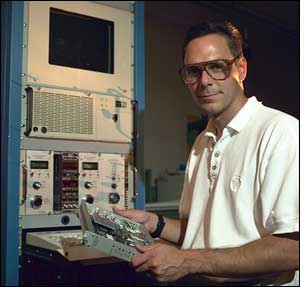The Savannah River National Laboratory (SRNL) and the United States Council for Automotive Research (USCAR) are in the first phase of a collaborative effort to develop a wireless sensor specification based on the 802.11 (Wi-Fi) standard. The goal of such a specification would be the creation of wireless sensors that can communicate in a manner that is more secure and faster than systems currently available.
The two organizations share a need for a wireless system that, thus far, does not yet exist. SRNL—the applied research and development laboratory located at the U.S. Department of Energy‘s Savannah River Site—provides research and technology support for the DOE’s management of its nuclear weapons stockpile and nuclear materials. As such, the lab seeks a highly secure system to monitor conditions in containers known as gloveboxes that hold radioactive material, and the auto industry is looking for a high-speed wireless tracking system for its robotic manufacturing system.
SRNL tracks air pressure, temperature and other conditions within stainless steel and glass gloveboxes containing radioactive or chemically hazardous materials. Wired sensors require a great deal of expensive cable to connect them to a back-end system—as much as $2,000 per foot, says Joe Cordaro, an SRNL advisory engineer. Cabled sensors also pose a potential for leakage from the glovebox to the clean environment at the point through which the cable passes.
The containers themselves can measure from 8 feet to more than 30 feet in height. A wireless connection would make it possible to accomplish the sensor monitoring without the cable, by using the Wi-Fi air-interface protocol to transmit sensor data to a Wi-Fi network access point, wired to the back-end server. However, Cordaro explains, the security of that transmission is the DOE’s greatest concern—there simply is no wireless system with the level of security the agency would need with such a system. The DOE requires a system in which an outside party could not, under any circumstance, decipher the data being transmitted.
The DOE tested hardware compliant with the 802.15.4 standard (known as a low-rate wireless personal area network, commonly used in ZigBee-based systems) but found that the system was not only insufficiently secure, it was also not fast enough to transmit data 24 hours a day at the rate the agency needed the information sent. “For us, none of the commercial hardware meets our security needs,” Cordaro says. “We are looking for very high-security, high-speed communication, and so far, it just hasn’t been there for us.”
USCAR, the automotive technology organization for Chrysler Group, Ford Motor Co. and General Motors Corp. (GM), has problems with the existing wireless platforms as well, says Gary Workman, GM’s principle engineer and chair of USCAR’s Plant Floor Controllers Networks Task Force. Manufacturers currently transmit car-assembly instructions to robotic arms via a cable extending the length of those arms. The cables often wear out, Cordaro says, and thus require a great deal of maintenance. All three manufacturers have already been looking into wireless technology with their own individual pilots and research, he notes, but the proprietary systems they’ve considered have had shortcomings and cannot be shared throughout the industry.
The assembly floor of an automobile manufacturer can have hundreds of sensors located in a small area, Workman says, and automakers need a system that can read all such sensors reliably. Wireless systems tested by automakers, he notes, have typically been too slow. “We need a round-trip 10-millisecond return on transmission,” he says, referring to the rate at which data is transmitted and received. In contrast, 100 milliseconds has been the common round-trip transmission rate with the wireless hardware they have tested to date. “A robot needs to know what the part in front of it is, while the part is in front of it,” he explains. “One hundred milliseconds doesn’t do the job.”
Because of this shortcoming, Workman says, the auto industry rarely employs wireless sensors. But the need for wireless technology is high, since the cables that pass along the robotic arms get flexed so frequently that they tend to deteriorate very quickly. “We’re interested in a secure, high-speed wireless platform,” he summarizes, though for carmakers, speed is a greater priority than security.
SRNL first began looking into a standards platform for wireless sensors approximately three or four years ago, Cordaro says—for its own use, as well as for the government’s. About 18 months ago, USCAR joined these efforts, first discussing its common needs with the lab, then signing a cooperative agreement in January of this year to develop a standard. Since then, SRNL and USCAR have worked to develop the specification, and the team next plans to go to technology vendors in the hope of having prototypes sometime in 2010.
In the meantime, Workman says, the automakers have agreed to share the results of their previous research into wireless sensors among SRNL and USCAR members, “including our individual assessment of products in the market.”
“Certainly, our hope is for a standard,” Workman states. “There is already a fair amount of proprietary technology out there, but no spectrum of wireless sensors that the variety of users require. We would hope to have a standard with which we can buy technology from multiple vendors with interoperability.” A secure and high-speed wireless system for the auto industry, he says, “would increase productivity and provide cost savings.”
Although Cordaro declines to provide details regarding the specifications the team has developed, he says the standard sought would provide the highest security of any existing wireless sensor system, using advanced encryption algorithms and operating at high speed. Once vendors provide a prototype, Cordaro says, SRNL plans to test it at the lab’s 300-square-mile compound at the Savannah River Site.



